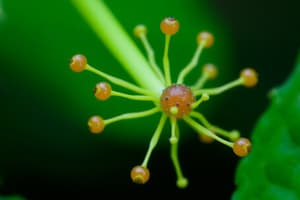Podcast
Questions and Answers
What is the most abundant type of fat found in living beings?
What is the most abundant type of fat found in living beings?
- Fats (correct)
- Steroids
- Phospholipids
- Waxes
Which elements are carbohydrates formed by?
Which elements are carbohydrates formed by?
- Hydrogen, nitrogen, and oxygen
- Carbon, nitrogen, and phosphorus
- Phosphorus, carbon, and oxygen
- Carbon, hydrogen, and oxygen (correct)
Which of the following are building blocks of lipids that constitute the organism´s energetic reserve?
Which of the following are building blocks of lipids that constitute the organism´s energetic reserve?
- Gases
- Fatty acids (correct)
- Proteins
- Amino acids
What is the focus of study in Cytology?
What is the focus of study in Cytology?
What is the most important function of structural lipids?
What is the most important function of structural lipids?
What does zoology focus on?
What does zoology focus on?
Which of these is a characteristic of waxes?
Which of these is a characteristic of waxes?
What can proteins and carbohydrates be transformed into?
What can proteins and carbohydrates be transformed into?
Which of the following fats are liquid at room temperature?
Which of the following fats are liquid at room temperature?
What are monosaccharides known as?
What are monosaccharides known as?
What is Taxonomy?
What is Taxonomy?
What is the function of transporter lipids?
What is the function of transporter lipids?
From what language does 'Biología' proceed from?
From what language does 'Biología' proceed from?
Which of the following represents building blocks of matter?
Which of the following represents building blocks of matter?
What does genetics study?
What does genetics study?
The origin and transformation of living beings through time is studied by which branch?
The origin and transformation of living beings through time is studied by which branch?
Which of these options does not define an objective of biology?
Which of these options does not define an objective of biology?
Which of the following food types originates from an animal source and also contains saturated fat?
Which of the following food types originates from an animal source and also contains saturated fat?
The study of microorganisms is best categorized under which biological branch?
The study of microorganisms is best categorized under which biological branch?
What is a primary role of botany in biology?
What is a primary role of botany in biology?
Flashcards
¿What are lipids?
¿What are lipids?
Heterogeneous group of organic compounds formed mainly by carbon, hydrogen and oxygen. Some also contain nitrogen, phosphorus and sulfur.
¿What is the reserve lipid function?
¿What is the reserve lipid function?
Serve as the main energy reserve in the organism in fats and fatty acids.
¿What is the transporter lipid function?
¿What is the transporter lipid function?
It transports liquids through bile acids and other compounds.
¿What is the catalysing lipid function?
¿What is the catalysing lipid function?
Signup and view all the flashcards
¿What lipids of biological importance are?
¿What lipids of biological importance are?
Signup and view all the flashcards
¿What are fats?
¿What are fats?
Signup and view all the flashcards
Proteins and carbohydrates
Proteins and carbohydrates
Signup and view all the flashcards
¿What are the two main types of fatty acids?
¿What are the two main types of fatty acids?
Signup and view all the flashcards
¿What are saturated fats source?
¿What are saturated fats source?
Signup and view all the flashcards
¿What are the unsaturated acids?
¿What are the unsaturated acids?
Signup and view all the flashcards
¿What foods contain unsaturated acids?
¿What foods contain unsaturated acids?
Signup and view all the flashcards
¿What are the functions of phospholipids?
¿What are the functions of phospholipids?
Signup and view all the flashcards
¿What are carotenoids?
¿What are carotenoids?
Signup and view all the flashcards
¿What are steroids?
¿What are steroids?
Signup and view all the flashcards
¿What are waxes?
¿What are waxes?
Signup and view all the flashcards
¿What are monosaccharides?
¿What are monosaccharides?
Signup and view all the flashcards
¿What are disaccharides?
¿What are disaccharides?
Signup and view all the flashcards
¿What are polysaccharides?
¿What are polysaccharides?
Signup and view all the flashcards
Branches of biology
Branches of biology
Signup and view all the flashcards
¿How matter is formed?
¿How matter is formed?
Signup and view all the flashcards
Study Notes
Ciencia (Science)
- Science from the latin "Scientia" means knowledge.
- Science is the body of knowledge that has been obtained through observation and systematic reasoning.
- This reduces to general principles and laws.
Biologia (Biology)
- Biology comes from the greek roots "bios" meaning life, and "logos" meaning study
- Biology refers to the study of life.
- Biology is a science that focuses on the structural organization and functioning of living things, whether current or fossils.
Ramas de la Biología (Branches of Biology)
- Botanica concentrates on organisms that are the base for every food chain.
- Botanica organisms also produces food and oxygen, that then cycles back into the atmosphere.
- Zoologia studies the consumers of the food chain.
- Microbiologia studies microbes and microorganisms
- Includes the decomposers of the food chain, Eukaryotas, and procariotas
- Procariotas are cells without a nucleus.
- viruses although aren't alive are also studied.
- Anatomia studies the structure, location, and relationship between the parts of the body.
- Bioquimica studies the composition and chemical processes that occur in living beings.
- Citologia studies the structure, composition, and function of cells.
- Ecologia studies the relationship of organisms between themselves and with their environment.
- Genetica studies the phenomoenon of biological heredity and variation.
- Paleontologia studies the fossil remains of organisms.
- Parasitologia studies parasitic organisms.
Importancia de la Ciencia y la Biologia (Importance of Science and Biology)
- Prevent, treat, and cure illnesses.
- Develop industries that use plant and animal products.
- purify the contaminated waters.
- Know the structure and function of the body to preserve health.
- Elaborate antibiotics and medicines.
- Produce vaccines and hormones.
- Production of transgenic plants that are resistant to plagues and produce rapid growth is soils that are not adequate.
- know other planets and forms of life.
- Elevate the quality of life for people through adequate, non contaminated eating habits, and a non contaminated enviroment.
Other branches of biology include:
- Taxonomia classifies organisms.
- Fisiologia studies the functions of organisms.
- Embriologia studies the formation and development of the embroyn.
- Evolucion focuses on the origin and transformation of living things across time.
Moléculas Constituyentes de la Materia Viva (Constituent Molecules of Living Matter)
- All matter is formed by atoms that are elements.
- The combination of these atoms create molecules, which form chemical compounds.
- Organic compounds are the primary constituents of cells and tissues.
- They participate in metabolic reactions, transmit information, and are a source of energy for biological processes.
The most important molecules are:
- Carbohydrates
- Lipids
- Proteins
- Nucleic acids
- Hormones
- Vitamins
Carbohidratos (Carbohydrates)
- Carbohydrates are formed by 3 elements: carbon (C), hydrogen (H), and oxygen (O)
- Carbohydrates are abundant in nature
- Carbohydrates are considered a primary source of energy.
Classification de los Carbohidratos (Classification of Carbohydrates)
- Monosaccharides are the simplest carbohydrates.
- Examples of monosaccharides are glucose, fructose, galactose, ribose, and deoxyribose.
- Disaccharides are formed by two monosaccharides that are equal or different.
- Common disaccharides include sucrose, lactose, and maltose.
- Polysaccharides are the most abundant carbohydrates.
- Common polysaccharides include starches, glucogen, celluose, and quiquina.
Lipidos (Lipids)
- Lipids are a heterogeneous group of organic compounds formed by: carbon (C), hydrogen (H), and oxygen (O).
- Some also have: nitrogen (N), phosphorus (P) and sulfur (S)
Funciones de los Lipidos (Lipid Functions)
- Lipids serve as a primary energy reserve within the organism in the form of fats and fatty acids.
- Lipids are a structural component of cellular membranes and provide consistency.
- As a transporter, lipids use the emulsion of liquids by billiard acids and other similar compounds.
- Emulsion allows transport by blood and lymph from the intenstines to the spot of use.
- Lipids can be stored in the lympho adypocyte (fatty tissue) to be stored.
- As a catalyst, lipids facilitate chemical reactions in living beings.
Los lipidos de mayor importancia biologica son (most important biological lipids)
- fats
- phospholipids
- carotenoids
- steroids
- waxes
Grasas (Fats)
- Fats are the most abundant in living beings and are a way of storing food reserves.
- Fats generate more than twice the energy per gram that carbohydrates do.
- Both proteins and carbohydrates can turn into fats.
- These store up in fat cells, in adypose tissue where they serve as an isolator against the loss of body heat.
- There are two types of principal fatty acids: saturated and insaturated.
- The saturated fatty acids produce solid fats at room temperature, and are from animal foods.
- Animal origin foods are red meats, butter, and some plant originate like palm oil and coconut.
- Unsaturated fatty acids form liquid oils at room temperature.
- saturated fats can be monounsaturated or polyunsaturated.
- Monounsaturated fats are olive oil.
- Polyunsaturated fats can be found in dry fruits like peanuts, avacados, and their oils.
Other Lipids
- Phospholipids are a major component of cell membranes.
- Phospholipids are needed for the transport of substances with different degrees of polarity.
- Carotenoids are organic and liposoluble pigments with an oil consistancy that become synthesized
- Steroids are lipids derived from the perhydrofenantreno compound.
- Waxes are simple, insoluble lipids in water, and solid at room temp
- Waxes moldable esters of fatty acids with long chains of alcohol.
Studying That Suits You
Use AI to generate personalized quizzes and flashcards to suit your learning preferences.




